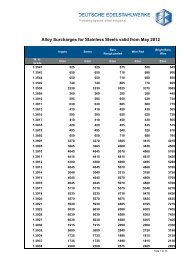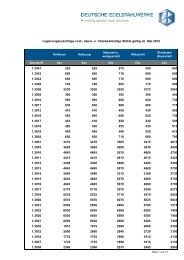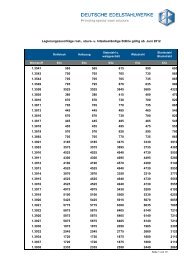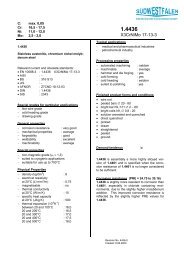Nitriding steels: Nitrodur - DEW-STAHL.COM
Nitriding steels: Nitrodur - DEW-STAHL.COM
Nitriding steels: Nitrodur - DEW-STAHL.COM
You also want an ePaper? Increase the reach of your titles
YUMPU automatically turns print PDFs into web optimized ePapers that Google loves.
Excessive nitriding<br />
may lead to a more<br />
pronounced connecting<br />
layer and the<br />
formation of a nitride<br />
network around the<br />
grain boun daries.<br />
This increases<br />
brittle ness and thus<br />
also the risk of<br />
chipping.<br />
Thermo-Chemical Process of <strong>Nitriding</strong> that the layer composition can be optimised<br />
Gas <strong>Nitriding</strong> and Gas Carbo-nitriding<br />
The normal temperature range for gas nitriding<br />
and gas-carbo-nitriding is 450° C ≤ T ≤ 590° C.<br />
The crucial factor in gas nitriding of the component<br />
is the release of diffusible N by means<br />
of a gradual reduction of ammonia and its<br />
absorption in the surface of the component.<br />
In some cases, NH3 is added to the fresh<br />
gas, which dilutes the NH3 content.<br />
In the so called oxi-nitriding process, oxygen,<br />
generally in the form of air, is used to intensify<br />
the nitriding process. Oxi-carbo-nitriding<br />
is used to treat passivated surfaces. For gascarbo-nitriding,<br />
diffusible carbon is added. It<br />
is generally added in the form of CO and CO , 2<br />
either pure or as part of a gaseous mixture<br />
(e.g. endogas or exogas). In gas sulphonitriding,<br />
sulphur or hydrogen sulphide is added to the<br />
ammonia. Though the process leads to better<br />
wear characteristics because sulphur is deposited<br />
in the connecting layer, it is seldomly<br />
used in Germany. Unlike other methods, gas<br />
nitriding and gas-carbo-nitriding can achieve a<br />
variety of different structures, connecting layer<br />
thicknesses and nitriding hardness depths.<br />
The batch setup of the product to be nitrided<br />
can be adjusted to the component shape. The<br />
methods are suitable for large and small parts.<br />
Please note that special safety precautions must<br />
be met due to the use of flammable gases.<br />
Connecting layer<br />
Nitride network<br />
Diffusion zone<br />
Plasma <strong>Nitriding</strong> and Carbo-nitriding<br />
Plasma nitriding and carbo-nitriding is performed<br />
at temperatures between 350 and 590°<br />
C. Positively charged ions strike the component<br />
that acts as a cathode at high velocities<br />
in front of the furnace wall (anode). In the<br />
beginning, this ion bombardment causes the<br />
component surface to be cleansed (sputtering)<br />
thus allowing passive layers of specialty<br />
<strong>steels</strong> to be removed. Then it is heated and<br />
the component surface is nitrided. Pulsed<br />
discharges increase the uniformity in the batch<br />
and lower the energy transfer in the plant.<br />
Placing a negative active screen between<br />
the positive furnace wall and the negative<br />
components leads to glow discharge on the<br />
screen. In high-alloy materials, nitriding is uniform<br />
and passivating layers can be removed<br />
even without sputtering. This method is also<br />
called ASPN (active screen plasma nitriding).<br />
The advantage of treatment in plasma is<br />
14 15<br />
(e.g. thin connecting layers with high Nht).<br />
The treatment is easy to reproduce and<br />
results in minimal changes in dimension.<br />
Compared to nitriding in gas or salt baths,<br />
it results in the lowest level of coarseness.<br />
Component charging, however, requires<br />
exact definitions and plasma cannot enter<br />
crevices smaller than 0.6 to 0.8 mm.

















